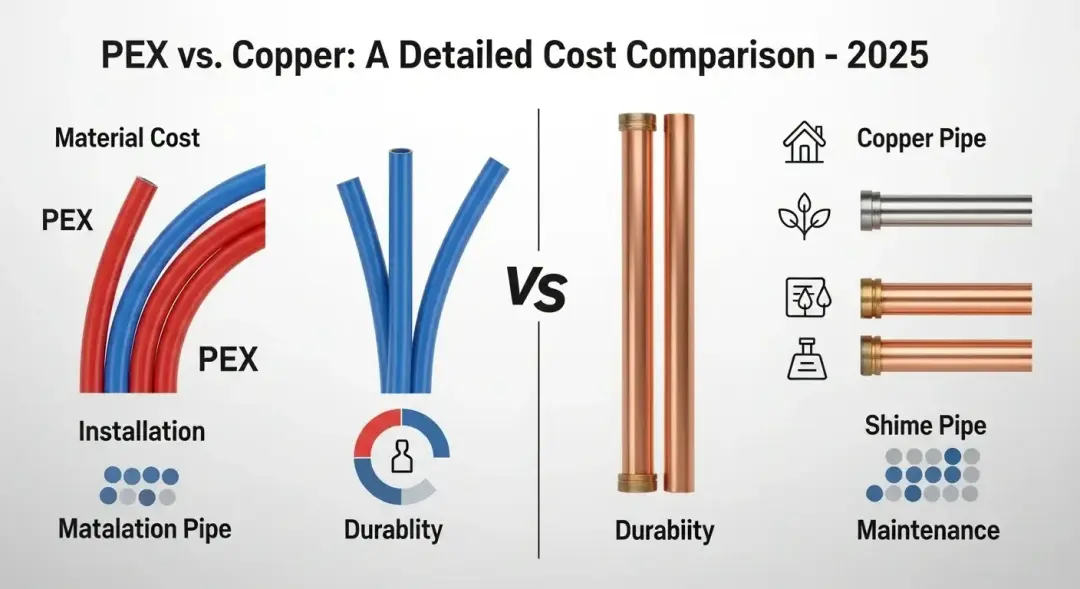PEX vs. Copper Piping Cost in 2025: Your Ultimate Homeowner’s Guide
Planning a plumbing project for your home, whether it’s a new build or a renovation, involves many crucial decisions. One of the most significant choices homeowners face is selecting the right piping material: PEX vs. copper. Both have distinct advantages and disadvantages, but for many, the overall cost is the primary deciding factor.
This comprehensive guide will delve into the 2025 pricing trends for both PEX and copper pipes. We’ll meticulously break down material costs, installation expenses, long-term value, and maintenance considerations so you can confidently make the best plumbing choice for your residence and budget.
PEX vs. Copper: Understanding the Fundamental Differences
Before diving into a detailed cost comparison, let’s quickly review the core characteristics that set PEX piping and copper piping apart. This table highlights key features to help you understand their unique properties.
| Feature | PEX Pipes | Copper Pipes |
|---|---|---|
| Material | Cross-linked polyethylene (flexible plastic) | Metal (pure copper) |
| Installation | Faster, simpler, fewer fittings required | Requires soldering, more labor-intensive |
| Durability | Excellent resistance to freezing & corrosion | Long-lasting but can be prone to corrosion |
| Flexibility | Highly flexible, can bend around obstacles | Rigid, requires more fittings for turns |
| Lifespan | 30-50 years | 50+ years (often outlasts the home itself) |
| Noise | Quieter water flow | Can sometimes produce water hammer noise |
| Chemicals | Resists chlorine and other water treatments | Generally inert, but can react with acidic water |
| Recyclability | Recyclable, but less commonly recycled | Highly recyclable, valuable scrap metal |
PEX vs. Copper: A Detailed Cost Comparison for 2025

Understanding the financial implications of each piping material is crucial for your plumbing budget. Here’s a breakdown of the costs you can expect in 2025.
1. Material Costs
The initial purchase price of the pipes themselves is often the first cost homeowners consider.
PEX Pipes:
Expect to pay between $0.40 to $2.00 per linear foot. This cost can vary significantly based on the PEX pipe type (e.g., PEX-A, PEX-B, PEX-C), brand reputation, and pipe thickness (e.g., 1/2-inch, 3/4-inch, 1-inch PEX).
Copper Pipes:
Copper pipe prices typically range from $3.00 to $8.00 per linear foot. The price will depend on the copper pipe type (e.g., Type L copper for general plumbing, Type M copper for less demanding applications), wall thickness, and market fluctuations for metal commodities.
Why the Price Difference?
The fundamental difference in material cost boils down to manufacturing and market forces. PEX tubing is a synthetic, flexible plastic, making its production less expensive and its price more stable. Conversely, copper piping is a metallic commodity whose price is directly influenced by global metal markets and supply chain factors, leading to greater volatility and generally higher costs.
2. Installation Costs
Beyond the material itself, the labor involved in plumbing installation contributes significantly to the overall project cost.
PEX Installation:
On average, PEX installation costs range from $0.50 to $2.00 per foot. The flexibility of PEX allows plumbers to run longer, continuous lines with fewer fittings and connections, reducing labor time.
Copper Installation:
Copper pipe installation costs are considerably higher, typically between $5.00 to $10.00 per foot. This is due to the inherent rigidity of copper, which requires more cutting, precise measuring, and soldering at every joint and bend. Soldering is a skilled, time-consuming process that adds to plumbing labor costs.
Significant Labor Savings with PEX
One of the most compelling cost-saving benefits of PEX is the reduced labor. Since PEX is lightweight, flexible, and often uses crimp fittings or expansion fittings instead of soldering, plumbers can install PEX up to 3 times faster than copper. This efficiency directly translates into lower plumber fees and overall project savings.
3. Long-Term Costs & Maintenance
Considering the long-term value and potential maintenance expenses is vital for a complete cost assessment.
PEX:
PEX is highly resistant to scale buildup (mineral deposits) and is particularly lauded for its freeze resistance. Its flexibility allows it to expand significantly without bursting if water freezes inside, leading to fewer pipe burst repairs and lower home insurance claims related to water damage. PEX generally requires minimal maintenance.
Copper:
While robust, copper can be susceptible to corrosion over time, especially in areas with acidic water (low pH). Pin-hole leaks from corrosion are a common issue that can lead to costly water damage repairs and require re-piping. Copper is also more vulnerable to bursting in freezing conditions if not properly insulated or drained.
Which Lasts Longer: PEX or Copper?
Traditionally, copper pipe lifespan is cited as 50+ years, often outliving the home itself. PEX pipe lifespan is typically estimated at 30-50 years. While copper may theoretically last longer, the cost-effectiveness of PEX over its substantial lifespan, coupled with its resistance to common issues like freezing and corrosion, makes it a more economically sensible choice for most modern homes.

